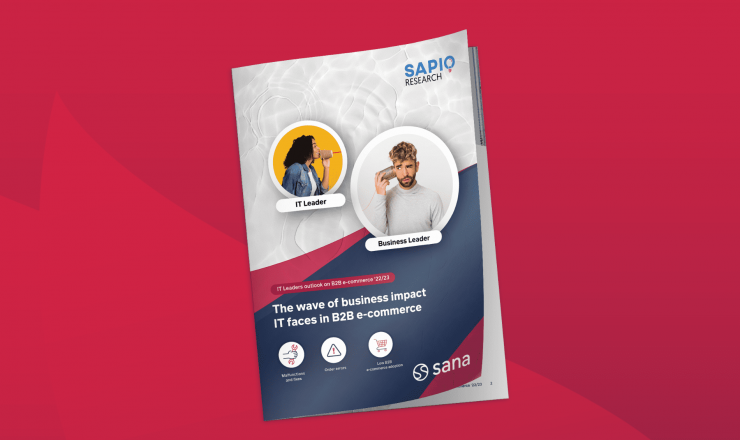

B2B commerce is at the start of another shift as opportunities such as AI and continued digitization reach new levels of maturity. When looking at forecasting your business outlook for 2024, B2B leaders should keep in mind the top B2B e-commerce trends for 2024 and see how they can take advantage of these developments.
We sat down with Sana Commerce’s Chief Technology Officer, Arno Ham, to hear what he had to say about what B2B product sellers can expect to see in 2024. Arno has nearly 20 years of experience in B2B commerce working for customers like Heineken and AkzoNobel.
1. Improving efficiency through better e-commerce adoption
In 2023, commerce solutions didn’t deliver the efficiencies B2B companies expected. In 2024 they will look to improve usage, or adoption rates, amongst their customers to close the gap between expectations and performance of their e-commerce initiatives. Important themes will be streamlining operations and enhancing overall business performance. Companies that get it right will see increased customer satisfaction, better reorder rates and significantly reduced administration costs.
The emphasis is on adopting solutions that both streamline operations and enhance overall business performance. Much of the B2B space operates with tight margins, so every little efficiency improvement counts. If a B2B business is investing money into a tool or solution that isn’t closing the adoption gap, then it’s costing your business money right now.
According to Arno, there are a few reasons why digital commerce can make your business more cost efficient in 2024:
- Digital cost-per-lead (CPL) is significantly more cost effective than offline methods, with SEO costing $35 CPL on average while cold calling is a staggering $300 CPL on average.
- Digital commerce can answer customer inbound queries about product specifications and required bill of materials before the customer has even asked them, unburdening your sales teams.
2. Focus on digitizing complex B2B business processes
According to Arno, there’s still a knowledge gap about how the complexity of B2B sales and processes fit into a digital commerce model. Fortunately, there is a rise in technologies that are helping translate complexity online.
Historically, manufacturers like automotive parts or medical supplies have struggled to sell online due to the high number of variants and built for purpose functions of their products. The complexity of the transactions and the cost implications of getting it wrong made digitizing either too risky or not worth the effort. But things are changing rapidly as solutions providers and platforms race to enable sophisticated, complex online selling.
The rise of Configure, Price, Quote (CPQ) systems, such as Expivi and Experlogix, allows for customers to visually configure their perfect order, making customer satisfaction easier to achieve. CPQ vendors recognize this trend and are tailoring their offerings to make it easier for B2B companies to implement. These systems not only streamline pricing configurations but also contribute to a more efficient and error-free quoting process.
3. Centralizing composable commerce
Composable commerce has been trending in the B2B landscape for a few years now. Composable commerce is the development strategy of choosing top-performing commerce elements and integrating or “composing” them to create a tailored application designed to meet specific business requirements. Businesses have come to know the benefits it provides with flexibility and scalability, aligning with the dynamic nature of B2B operations.
However, there’s been more talk recently about where composable commerce is limited. Let’s face it: there’s nothing optimized about having hundreds of different applications communicating and competing with one another.
According to commerce reporter Zhi Xuan Wu, composable commerce can often be taxing on developers and costly for digitally immature organizations. The focus shifts away from the functionality of the individual applications to the “connective tissue” that keeps the applications in sync with one another.
Arno introduces a new angle on composable commerce saying:
“In 2023, we’ve learned that business leaders in B2B are expecting more from the tools they use. This is an organizational-wide shift. It’s not just IT leaders who are focusing on this anymore. So, everyone is being asked how much functionality and integration these new applications are really bringing to the table. These tough questions mean that a focus has also returned to products that can do more and integrate more with their specific business landscape.”
4. Going all in on SaaS with extensibility
As companies forecast for the coming year, they can’t escape the staffing pressures that have been a part of the business landscape since 2021. Particularly, finding talented developers has been more difficult than ever, making bespoke development projects more difficult to get across the finish line.
According to Arno, this fits with shifts we’ve seen in the market at the mid-level and enterprise ranges. In 2024, B2B businesses are realigning their goals and moving to adopting SaaS tools to help them grow faster and more sustainably. This helps take the burden of development off their teams and gets them to the frontier of digital commerce faster.
A good example of this comes from AOSS Medical Supply, who opted for a strategic adoption of their B2B commerce platform, Sana Commerce Cloud, to meet their growing base of customers. Sana Commerce Cloud is a ready-to-use B2B commerce platform that is engineered to bring complex processes online, unburden teams, and get to value faster. This helped AOSS achieve:
- A 100% increase in their web store uptime due to smart integration
- Full commerce adoption by their entire customer base
- Sales team members saving a minimum of 50 hours (about 2 days) on administrative tasks
5. Digitization requires gauging e-commerce maturity
Arno emphasizes that every B2B product seller is different and is starting at a different place. It’s the complexities in B2B that put every business at a separate starting point.
Arno’s claim is corroborated in a recent survey performed by Digital Commerce 360, which found:
“Many companies haven’t fully reached connected B2B commerce. The survey found that only 17% of respondents said they offered full end-to-end integration of commerce transactions. That includes procurement software and punchout catalogs and automation of purchase orders and invoices.”
To use an example, many B2B businesses that contain a high degree of product complexity due to their huge assortment and variety of SKUs probably have Product Information Management software like Channel Engine. For efficiency purposes, it’s important that any commerce software added to this landscape be integrated with this PIM software.
6. Generative AI for process and efficiency improvements
2023 has been the year of Generative AI going mainstream. Sana Commerce quickly implemented AI to help B2B businesses write comprehensive product descriptions and enhance product imagery. However, that’s just scratching the surface of what AI can do to help reduce costs in your B2B business.
Generative AI is now emerging as a powerful tool for process optimization and efficiency improvements, as well. Arno explained that using machine learning principles, AI can perform a diagnostic on your business processes and identify areas of inefficiency. From there, the business decision makers will be presented with generated suggestions that can allow them to smoothen out these processes in the click of a button.
In a report published this year by McKinsey, they “identified 63 generative AI use cases spanning 16 business functions that could deliver total value in the range of $2.6 trillion to $4.4 trillion in economic benefits annually when applied across industries.”
Arno predicts that 2024 will be the year of further integrating AI into these strategic business initiatives. The integration of generative AI is expected to bring about a paradigm shift in how businesses approach automation and decision-making.
7. More choice and flexibility in B2B payments
B2B buyers want more flexibility when and how they choose to pay, particularly for big ticket orders. But providing those flexible options comes with a high degree of complexity. Just a few of the payment services B2B buyers want:
- Pay on account
- Pay on loan
- Pay with multiple payment methods
- Pay using a parent account for multiple subsidiaries
According to Ryan Frere, EVP & GM at fintech company Flywire, “[Flexible payment methods] applies even more so to international customers who generally prefer to be billed and pay in their local currency. Many companies still bill their international customers in the biller’s own currency and then rely on international wire and bank transfers for payment, creating a lot of unnecessary cost and complexity – for all involved.”
In this way, B2B product sellers are moving in the direction of providing financial services and products to their customers in a similar way that banks do. This is new and entirely unique to B2B spaces.
8. Real-time data is make or break in B2B
Advanced analytics and real-time data updates have moved from competitive advantage to “required for survival” for most manufacturers and distributors who rely on these insights to manage inventory levels, forecast and deliver business profitability.
For traditional sales channels these systems are the heartbeat of the business but enabling this real time visibility for online selling is still a challenge for many. To grow to the next level, many mid-sized B2B businesses in 2024 will evaluate digital commerce solutions that can help them sell online with the same real-time accuracy as offline. Arno added:
“Of course, there are other efficiency benefits with real-time syncing like reducing order errors. That can actually boost revenue in the long run as customers come to rely on your web store as a dependable place to get their goods on time.”
Lining up for success in 2024
The trends shaping B2B commerce in 2024 reflect a holistic approach to digital transformation. From improving efficiency and handling complexity to embracing cutting-edge technologies like generative AI, businesses are navigating a dynamic landscape. The key to success lies in agility and adaptability that align with the unique demands of B2B operations.

Want to build a data-driven strategy in 2024?
It all starts with knowing what your customers want. Read the 2024 B2B Buyer Report here.




